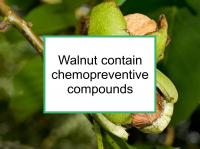While walnuts are known for their relatively high levels of the omega-3 fatty acid alpha-linolenic acid (ALA), walnuts are also remarkable in having the highest total flavonoid contents and antioxidant activity of any nut commonly consumed in the U.S. As such, they are superior to similar nuts such as pecans. Walnut oil is also beneficial.
Walnut extracts and walnut compounds such as ellagic acid, urolithin A, β-sitosterol and melatonin have been shown to inhibit the growth and proliferation of both hormone receptor positive (ER+/PR+) and triple negative (ER-/PR-/HER2-) breast cancer cells.
One study demonstrated that walnut extract induced beneficial changes in gene expression in ER+/PR+ breast cancer cells, including decreased expression of genes that have been linked to cancer progression. Other studies have reported that mammary tumor number and size was reduced in mice fed walnuts. Now a new review has summarized the health benefits of walnuts.
Making the most of walnut consumption
ALA is converted during metabolism into eicosapentaenoic acid (EPA) and docosahexaenoic acid (DHA), the main omega-3 fatty acid components of fish oil. EPA and DHA have been reported to have chemopreventive effects in multiple studies.
For example, they have been shown to reduce lung metastasis in a mouse model of breast cancer and to inhibit the early stages of HER2 overexpressing (HER2+) breast cancer. However, the conversion of ALA can be blocked in the presence of vegetable oils with high omega-6 fatty acid content. These include corn oil, safflower oil, soybean oil, and sunflower oil. Therefore, walnuts and walnut oil should be consumed separately from such oils.
In addition, walnuts (but not walnut oil) are a source of dietary copper. While copper deficiency can lead to anemia and other serious conditions, copper can also help tumors acquire a blood supply through angiogenesis (new blood vessel growth).
Copper is also associated with increased cancer cell proliferation. Women who take supplements containing copper have been found to have a higher risk of breast cancer. In addition, breast cancer patients have been found to have higher levels of copper in their bloodstreams than women without cancer.
Therefore, based on the need for adequate but not excessive copper consumption, it makes sense for breast cancer patients and survivors to limit their copper intake to the RDA of approximately 0.9 mg per day, an amount contained in two ounces of walnuts. It is best to use the daily copper allowance for beneficial foods such as walnuts rather than less desirable high-copper foods such as liver and oysters.
Latest review reports pedunculagin is the main walnut polyphenol
The study referenced at the beginning of this news story was designed to investigate the micronutrient content and benefits of walnuts. Walnuts have traditionally been known for their favorable fatty acid profile, which has been found to have multiple health-promoting effects.
However, walnuts also contain other bioactive compounds, including vitamin E and various polyphenols (the most abundant antioxidants in the typical diet). In fact, among foods commonly consumed, walnuts are one of the most important sources of polyphenols. The main walnut polyphenol is pedunculagin, an ellagitannin.
After consumption, ellagitannins are hydrolyzed to release ellagic acid. Ellagic acid is converted in turn by gut microflora to urolithin derivatives (most importantly, urolithin A, but also urolithins B, C and D). Ellagitannins and ellagic acid are also present in fruits such as pomegranates, strawberries, raspberries, and blackberries. Ellagitannins have well known antioxidant and anti-inflammatory properties.
A number of studies have examined the potential role of ellagitannins against disease initiation and progression, including cancer, in addition to cardiovascular and neurodegenerative diseases.
The remainder of the authors' review summarizes current findings regarding the potential effects of walnut polyphenols in the maintenance of health and prevention of disease.
